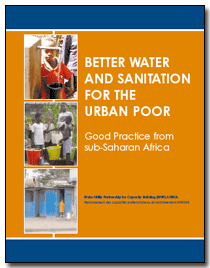|
||
|
|
||
|
||
| TABLE OF CONTENTS (links are to pdf versions) Cover PART ONE - INCREASE ACCESS TO IMPROVED WATER SUPPLY PART TWO - INCREASE ACCESS TO IMPROVED SANITATION PART THREE - INCREASE ACCESS THROUGH PRO-POOR POLICY Annex 1: The WUP 5 Case Studies
|
||
| INTRODUCTION
What is the purpose of this document? This document aims to: How was this information compiled? The information provided in each section of this document has been gathered through a comparative study of water and sanitation services in nine African countries. Based on the knowledge and recommendations of sector practitioners, this investigation (called WUP 5)1 documented ‘good practice’ – examples of effective policy development and implementation in delivering water and sanitation services to the urban poor. Who is the target audience? This document is intended for practitioners in the water and sanitation sector, especially policy and decision-makers involved in the development and/or delivery of water and sanitation services to low-income urban communities. These actors may be associated with water supply and sewerage utilities, line ministries, municipal governments, non-governmental organizations, bilateral or multilateral institutions or the private sector. What does this document provide? The document is structured in three parts covering the key thematic areas – water supply service delivery, sanitation service delivery and overall policy. Each part describes a series of different actions that can be taken to improve service delivery to lowincome communities, outlines key lessons and challenges and identifies the principles of good practice. Each chapter is illustrated with WUP5 case study material and, where appropriate, selected good practice from other regions has been used to supplement the illustrative material from sub-Saharan Africa. One of the main observations of the authors is that there is never just one solution to any particular problem. Within each country context, the key to a successful strategy lies in the capacity of practitioners working in the water and sanitation sector to innovate and to adapt solutions to address local constraints and opportunities. This document therefore aims to provide the reader with information and examples to support this localized approach, enabling practitioners to draw up a suitable course of action – one that is tailored to local circumstances but builds on regional experience. As such, the document is not intended to recommend specific actions or to prescribe specific practice or policy to be implemented by practitioners and policy-makers, but to provide a source of information for consideration. |
||
|
|
||
| Bibliography Links: |
||
|

